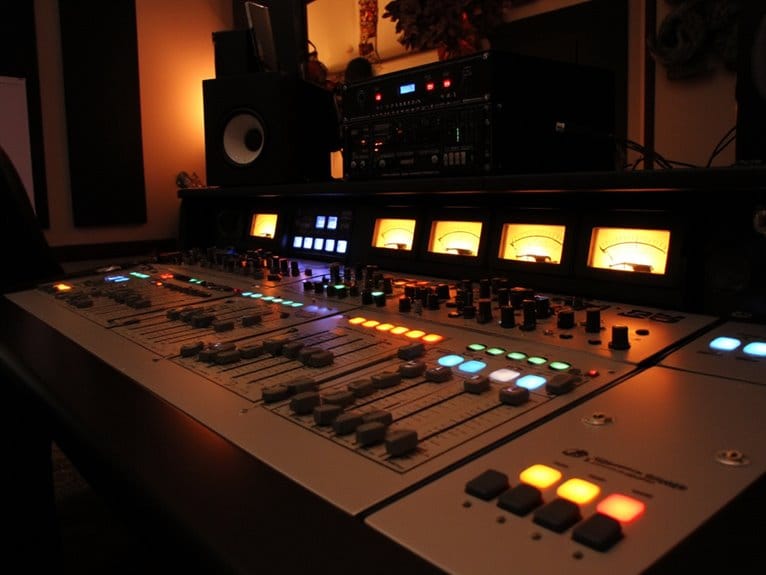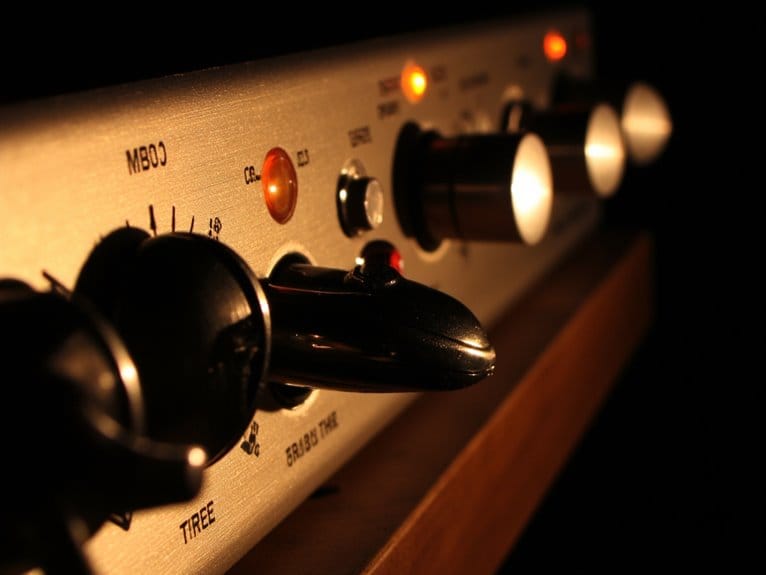What Is Mastering?
Mastering is the final audio production step where you’ll transform your completed stereo mix into a polished, distribution-ready track that sounds consistent across all playback systems, from earbuds to stadium speakers. You’re fundamentally applying subtle EQ adjustments, compression, and limiting to achieve commercial loudness standards around -14 LUFS while removing clicks and pops that could distract listeners. This process differs from mixing since you’re working with the complete stereo file rather than individual tracks, focusing on that essential 20% technical polish that makes your music competitive on streaming platforms. The techniques we’ll explore reveal how professionals achieve that signature commercial sound.
We are supported by our audience. When you purchase through links on our site, we may earn an affiliate commission, at no extra cost for you. Learn more.
Notable Insights
- Mastering is the final production step that transforms mixed songs into polished, distribution-ready tracks for commercial release.
- It prepares music for various formats like vinyl, CD, and streaming while ensuring optimal playback across different systems.
- Key techniques include subtle equalization, strategic compression, and limiting to achieve commercial loudness standards around -14 LUFS.
- Unlike mixing which balances individual tracks, mastering works with the complete stereo mix using specialized tools and processors.
- The process involves preparation, processing phases, and final quality checks to create professional masters in lossless formats.
The Role and Purpose of Mastering in Music Production
When you’re listening to your favorite album and every track flows seamlessly from one to the next with consistent volume and crystal-clear sound, you’re experiencing the magic of professional mastering-the final, essential stage that transforms a collection of mixed songs into a polished, cohesive musical experience.
The mastering importance becomes evident when you consider that this process prepares your music for distribution across vinyl, CD, streaming platforms, and radio, ensuring ideal playback on everything from smartphone speakers to stadium sound systems.
Beyond technical optimization, mastering benefits include establishing commercial loudness levels, removing audio distractions like clicks and pops, and applying subtle equalization and compression that enhances your mix’s overall sonic character without compromising its artistic integrity. The mastering engineer listens to the entire stereo mix to enhance sound quality using specialized tools like compressors, limiters, and equalizers.
This critical process also handles essential metadata conversion and sample rate adjustments required for various distribution formats, ensuring your music meets the technical specifications of different platforms and playback systems.
Key Techniques and Processes Used in Mastering
Mastering transforms your mixed tracks through a carefully orchestrated series of technical processes that I’ve refined over years of working with everything from indie bedroom recordings to major-label releases.
Honestly, the difference between amateur and professional results often comes down to understanding these five core techniques.
The gap between bedroom producers and chart-topping releases isn’t talent-it’s mastering these fundamental processing techniques.
Equalization techniques form the foundation, where you’ll apply broad, gentle adjustments to enhance tonal balance while scanning with narrow bandwidth to identify problematic frequencies.
Dynamic processing follows through strategic compression placement between EQ and limiting, controlling your track’s dynamic range without squashing its natural groove. Remember that over-processing can negatively affect the mix, so restraint is key to maintaining the track’s natural vitality.
The essential mastering workflow includes:
- EQ balancing – Subtle frequency enhancement without fixing major mix problems
- Compression control – Sparingly applied to meet loudness standards like -14 LUFS
- Limiting finalization – Maximum perceived loudness while preserving transparency
Throughout this process, mastering serves as the final stage of music production, ensuring your track achieves the ideal sonic qualities needed for professional release.
How Mastering Differs From Mixing
Understanding the distinction between mixing and mastering has saved me countless hours of frustration and helped dozens of artists avoid the common trap of expecting mastering to fix fundamental mix problems.
While mixing techniques focus on balancing individual tracks-adjusting vocals, drums, and guitars using EQ, compression, and effects-mastering works exclusively with your final stereo mix.
You can’t access separate elements during mastering, which relies on specialized mastering tools like limiters, stereo imaging processors, and loudness meters applied to the complete track.
Think of mixing as the creative stage where you craft 80% of your song’s character, while mastering provides the technical polish for the remaining 20%, ensuring your track sounds professional across different playback systems and meets industry standards. The critical listening phase during mastering determines exactly which adjustments your song needs to achieve that polished, distribution-ready sound.
Mastering also focuses on enhancing perceived loudness to ensure your track competes professionally with other releases in your genre.
The Evolution of Mastering Through Music History
The progression shows three critical technological shifts:
- Acoustic to electrical era (1925) – Vacuum tubes enabled amplification and clearer recordings.
- Magnetic tape introduction (1948) – Transfer engineers emerged, using corrective EQ for vinyl optimization.
- Digital revolution (1980s) – DAWs and MIDI transformed mastering into software-based processing.
Early engineers like Steve Hoffman pioneered creative EQ and compression techniques while compensating for medium limitations.
The introduction of stereo sound further expanded mastering capabilities, with Sterling Sound cutting the first stereo discs in the US in 1968, allowing engineers to manipulate stereo width and spatial elements alongside traditional frequency and dynamic adjustments.
Each era’s constraints-from shellac surface noise to tape hiss-forced innovative solutions that became artistic choices, proving that technical necessity often births creative expression. The acoustic era’s limited frequency range of 250Hz to 2,500Hz required mastering engineers to work within severe bandwidth constraints that shaped early recording aesthetics.
Essential Steps in the Professional Mastering Workflow
Building on these historical innovations, today’s mastering workflow has crystallized into a systematic approach that I’ve refined through countless sessions, where each step builds upon the previous one to transform raw mixes into polished, commercial-ready masters.
Your mastering checklist begins with preparation, guaranteeing proper headroom and audio clarity before processing begins. Critical listening follows, where you’ll assess the mix against references and check translation across multiple systems.
| Preparation Phase | Processing Phase |
|---|---|
| Bounce finished stereo mix | Apply EQ for tonal balance |
| Set proper headroom (-3 to -6 dB) | Use compression for dynamics |
| Remove clicks and artifacts | Employ limiting for loudness |
| Import reference tracks | Adjust stereo imaging |
| Analyze peak/loudness values | Apply final dithering |
Processing involves EQ, compression, and limiting to achieve professional standards, while sequencing and metadata guarantee commercial readiness before final delivery verification. When exporting your final mix, use lossless formats like AIFF or WAV at the original bit depth and sample rate to maintain maximum audio fidelity. Throughout this workflow, continuous practice and study with varied monitoring techniques ensure that each master meets professional quality standards across different listening environments.
On a final note
You’ve now discovered that mastering isn’t just technical wizardry, though I’ll admit the EQ curves and compression ratios can make your head spin initially. It’s the vital bridge between your raw mix and commercial release, where frequency balance, dynamic control, and loudness optimization transform good recordings into professional products. Whether you’re working with stems or stereo files, mastering guarantees your music translates consistently across playback systems, maintaining artistic integrity while meeting industry standards.






